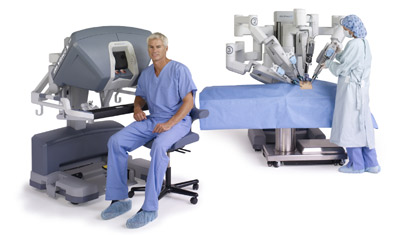Robotic Hysterectomies. Your Common Questions and Concerns Addressed.
A hysterectomy is an operation in which a woman’s uterus is surgically removed. This may be necessary as a form of treating cancer, uterine prolapse, or other dangerous diseases or medical conditions. Commonly, a laparoscopic hysterectomy is performed as a less invasive procedure using a lighted scope inserted through small incisions. Today, thanks to advances in modern medicine, an alternate form of laparoscopic surgery is available that in many cases speeds recovery and limits discomfort even more—and it involves, robotics.
What is a Robotic Hysterectomy
In robotic-assisted laparoscopic hysterectomy, a surgeon controls the surgical operating instruments using a computer located within the operating room. The benefit to computer-assisted operations is in the ability for all movements to be as steady and precise as possible. Robotics eliminate the possibility of human error, a possibility faced by even the most skilled and experienced surgeons. In addition, robotics allow surgeons to maneuver more precisely into tiny spaces, and with a better view of the area being operated on, again helping to improve accuracy and overall procedural success.
Robotic hysterectomies are typically done under general anesthesia. Commonly, three or four small incisions are made near the belly button. Gas is pumped into the belly to inflate the area and give the surgeon a better view of the interior region. The laparoscope is inserted into one of the abdominal incisions, while the surgical instruments are inserted into the others. Using the robotic controls, the surgeon cuts the uterus into pieces small enough to be removed through the abdominal incisions, or the uterus may be removed through the vagina. The entire procedure typically lasts between three and four hours.
When is a Robotic Hysterectomy Recommended?
Your surgeon may recommend a robotic hysterectomy for any of the following reasons:
- It is a less invasive procedure compared to an open type of hysterectomy, requiring only small incisions.
- It often produces less pain and results in a shorter hospital stay.
- It typically results in an easier recovery.
- There are fewer risks of complications such as excessive bleeding, or issues related to infection.
Are There Any Risks Involved?
As with any type of procedure, there are possible risks associated with a robotic hysterectomy. Talk to your OBGYN to understand the specific risk-factors that may impact you. In general, some of the risks associated with a robotic hysterectomy include:
- A reaction to the anesthesia. Robotic-assisted laparoscopic surgery usually takes longer than open surgeries. As a result, you are under anesthesia longer, which may increase your risk of complications.
- Abdominal, or internal organ damage.
- Blood clots that may form in your legs and travel to your lungs.
- Infection.
- Bleeding.
Other Important Factors
Talk to your OBGYN if any of the following additional risk factors may apply to you:
- You or someone in your family has ever had a negative reaction to general anesthesia
- You smoke
- You are taking any other regular medications
For more information about robotic, versus open hysterectomies, talk to your OBGYN. If you are a candidate for a hysterectomy due to a medical condition, your doctor will help you decide the surgical format that will offer the best results in treating your condition. And Chouchani, Sayegh and Bagnarello MD offers robotic assisted hysterectomies featuring the Da Vinci Surgical System. For more information call our office today.

